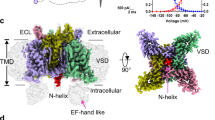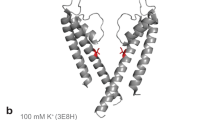Abstract
In a detailed structural model of the Na+ channel which has evolved over the past decade, the selectivity of the channel for cations1,2, the voltage-dependence of channel block by protons3 and other small cations2, and block by tetrodotoxin (TTX)4,5 all depend on the presence of a negatively charged site inside the channel that is part of a constriction called the ‘selectivity filter’. Much of the detail inherent in the model arises from Woodhull's quantitative desciption of the voltage dependence of Na+ channel block by protons3, in which the apparent relief of block observed at positive potentials occurs because the blocking site is located inside the sodium channel ∼25% of the way through the membrane voltage drop. I report here that proton block of skeletal muscle Na+ channels, determined from tail currents, is voltage-independent, and that the apparent voltage-dependent block of peak Na+ currents is instead an effect of low pH on channel kinetics. These results suggest that the proton binding site lies effectively outside the membrane field and thus at or outside the channel mouth. As a consequence, present models of the channel interior will need to be re-examined and substantially modified.
This is a preview of subscription content, access via your institution
Access options
Subscribe to this journal
Receive 51 print issues and online access
$199.00 per year
only $3.90 per issue
Buy this article
- Purchase on Springer Link
- Instant access to full article PDF
Prices may be subject to local taxes which are calculated during checkout
Similar content being viewed by others
References
Hille, B. J. gen. Physiol. 58, 599–619 (1971); 59, 637–658 (1972).
Hille, B. J. gen. Physiol. 66, 535–560 (1975).
Woodhull, A. M. J. gen. Physiol. 61, 687–708 (1973).
Henderson, R., Ritchie, J. M. & Strichartz, G. R. Proc. natn. Acad. Sci. U.S.A. 71, 3936–3940 (1974).
Hille, B. Biophys. J. 15, 615–619 (1975); Fedn Proc. 34, 1318–1321 (1975).
Ulbricht, W. & Wagner, H.-H. J. Physiol., Lond. 252, 159–184 (1975).
Carbone, E., Testa, P. L. & Wanke, E. Biophys. J. 35, 393–419 (1981).
Campbell, D. T. & Hille, B. J. gen. Physiol. 67, 309–323 (1976).
Carbone, E., Fioravanti, R., Prestipino, G. & Wanke, E. J. Membrane Biol. 43, 295–315 (1978).
Mozhayeva, G. N., Naumov, A. P. & Negulyaev Yu, A. Biochim. biophys. Acta 643, 251–255 (1981).
Pooler, J. P. & Valenzeno, D. P. Biochim. biophys. Acta 555, 307–315 (1979).
Adelman, W. J. & Palti, Y. J. gen. Physiol. 54, 589–606 (1969).
Carbone, E. Testa, P. L. & Wanke, E. Biophys. J. 35, 393–413 (1981).
Hille, B. J. gen. Physiol. 51, 221–236 (1968).
Drouin, H. & Neumcke, B. Pflügers Arch ges. Physiol. 351, 207–229 (1974).
Hille, B., Woodhull, A. M. & Shapiro, B. I. Phil. Trans. R. Soc. B270, 301–318 (1975).
Goldman, D. E. J. gen. Physiol. 27, 37–60 (1943).
Hodgkin, A. L. & Katz, B. J. Physiol., Lond. 108, 37–77 (1949).
Spalding, B. C. J. Physiol., Lond. 305, 485–500 (1980).
Mozhayeva, G. N., Naumov, A. P. & Negulyaev, Yu. A. Gen. Physiol. Biophys. 1, 5–19 (1982).
Author information
Authors and Affiliations
Rights and permissions
About this article
Cite this article
Campbell, D. Do protons block Na+ channels by binding to a site outside the pore?. Nature 298, 165–167 (1982). https://doi.org/10.1038/298165a0
Received:
Accepted:
Issue Date:
DOI: https://doi.org/10.1038/298165a0
Comments
By submitting a comment you agree to abide by our Terms and Community Guidelines. If you find something abusive or that does not comply with our terms or guidelines please flag it as inappropriate.



